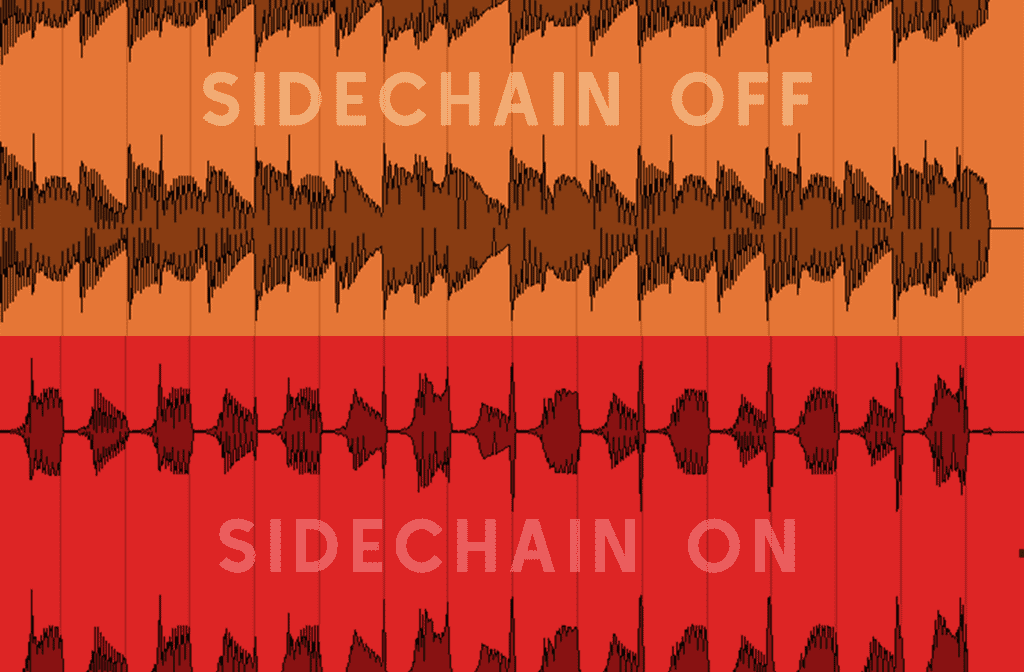Sidechaining has become a crucial and extremely powerful tool in the world of modern production. When utilized correctly this technique can add incredible depth and dynamic to your tracks and overall mix.
Sidechaining essentially creates room for an element in your mix by ducking the volume of another. So if it’s so great we better use it all the time, right? Well, using sidechain compression too much, or in unnecessary places can actually ruin your mix.
That’s why in today’s article I’ll explain what is sidechaining, when to use it, and how to achieve it in every daw.
What Is Sidechaining / Sidechain Compression?
Sidechaining is the process of lowering the volume of one element according to another one. You can use sidechaining to make space for elements within your mix and make sure everything sounds clear and punchy.
Have a look at this illustration to better understand it:

All The Scenarios When You Should Use Sidechaining
When people first get to know this thing called “sidechaining” they tend to use it everywhere, and all the time. However, this really ruins the mix sometimes.
I usually only use sidechaining in these scenarios:
Scenario #1: To balance kick & bass
Balancing the kick & bass is and has always been one of the hardest things to do in mixing. Since they’re both full of low-end they always fight and sometimes cancel each other out.
That’s why sidechaining really comes in handy in those situations.
Scenario#2: To balance kick & other elements
Just like the bass, the kick might fight with other elements in your song like your hihats or chords. That’s why it may be essential from time to time to sidechain other elements too.
Scenario #3: To create special FX
Sometimes, sidechaining can help you create really special sounding tracks. For example, Brooks told in one of his masterclasses that he likes to sidechain the reverb of his leads so it only plays when the leads don’t.
That way, he can keep the leads powerful and in the center of the mix, and still have the reverb fill up empty spaces.
In the rest of the article, I’ll mainly treat the first scenario as it is the most common one.
How To Use Sidechaining In Every DAW
To sidechain your kick & 808 load a compressor on the 808’s channel and send the kick’s channel to that compressor. Then, make sure that the makeup gain is 0, lower the threshold until you hear enough reduction, set the attack to (0ms-10ms) and the release to (40ms-150ms).
How To Sidechain With FL Studio
Place your kick and 808 next to each other on your mixer in FL studio (they need not be side by side but it makes your workflow much clearer and quicker).
Click the small arrow at the bottom of your kick drum’s fader and drag it over to your 808. This command creates a send routing from the kick to the 808.
Place the Fruity Limiter on your 808 channel switch to compression by activating the ‘Comp’ button on the interface. Open up the sidechain dropdown menu and select your kick as your input routing. The compressor is now activated by the routed kick signal.
Set your compression threshold below the peaking volume off the kick. Use your ear to determine where the kick and 808 cross over. You can also tweak the ratio to set the intensity of your compression. A 2:1 ratio is generally a good starting point for this type of compression.

The Attack knob adjusts how quickly the compression is triggered once the kick plays. A fast attack time creates a hard-hitting dynamic, while a slower attack generates a smoother compression.
Check the total length of your kick’s sample in milliseconds and set the release time around this point. You want the compression to be released as soon as most of the kick has punched through it.
How To Sidechain With Ableton
Place a compressor on the track you’d like to sidechain. The Ableton stock compressor is a simple and effective option. Open up the compressor’s sidechain tab which is indicated by a small triangle on the top left of its window.
Activate the sidechain option and set your input routing to your kick channel. The 808’s compressor will now be triggered by your kick drum.
You can use the compressor’s EQ to focus your compression on a specific frequency area of your 808. For this instance, use a high pass filter to cut out the sub end of your 808. The filter will allow the kick to play over the 808 without having their low-end frequencies clash.

Use the attack parameter to determine how quickly the compression triggers once the kick plays. Faster attacks add more punch, while a slower attack will create more of a swelling effect.
Make sure that your threshold is set below the peaking volume of your kick. If your threshold is set incorrectly it can cause clipping or make your processing sound imbalanced.
How To Sidechain With Logic Pro
Select the output routing on your kick drum channel on the mixer in Logic Pro. In the dropdown menu select the ‘bus’ option to create a new bus routing for your kick.
Open up a compressor on your 808’s channel. You can make use of the stock compressor or some simple plugins – such as Fab Filter Pro C-2 – provided that they have the option to the sidechain.
Select the sidechain option on your compressor and set the input routing to eternal mode Select your kick drum’s bus channel as the input. The kick should now trigger your compressor.
Use the threshold parameter to determine how deeply you want your kick to sink into your 808’ Lower thresholds take up less space, and vice versa.
Set the attack speed using your ear to determine your 808’s dynamics. The quicker your attack, the punchier your 808 will be, while slower attacks are less abrasive.
How To Sidechain With Cubase

Open up a compressor on your kick channel strip in Cubase. The stock compressor from Steinberg works just fine for this. Select the sidechain option at the top of the compressor’s window.
Open the channel settings on your kick channel and click on the sends tab. In the output routing, the dropdown menu selects the compressor that you have placed on the 808’s channel.
Set the attack speed to determine how quickly the compression is triggered when the kick plays. The fast attack creates a sharper dynamic, while the slower attack speed smoothes out the compression.
The release parameter will decide how quickly the compressor dies out once triggered. Short release times generate quick ducks in volume, while higher release times sustain the compression for a longer period.
You can use the threshold parameter to calibrate the density of your compression. The higher the threshold value, the deeper the compressor will cut into your 808.
You can use the make-up dial to even out the input and output levels for a more balanced compression. This will help create some extra cohesion between your kick and 808 after compression.
Mixing Notes
It’s important to remember that using a sidechain can be a pretty delicate process. Just like any compression tool, incorrect usage can cause your tracks or mix to sound muddy or squashed.
When using the attack and release parameters, try to create the audio image of the kick and 808 moving as one instrument. You want to try and create as much cohesion between the two as possible.
Always experiment with unconventional ratios or parameters to see if you can come up with something interesting, but make sure that you have a basic understanding of the fundamentals of sidechaining first.
Try to let your ears direct your mixing decisions when implementing a sidechain on a track. Your kick needs to sound present and prominent, but not to the point of overwhelming your entire mix.
If you’d like to find out more on enhancing your 808’s, check out our article on
5 Methods To Make Your 808’s Punchy That Actually Work. There are a handful of extra tips to help you get as much boost and clarity out of any 808 regardless of your DAW.
Having a strong, warm, and clean low end is one of the cornerstones of any great mix. Tools and techniques like sidechaining have become practically irreplaceable in the modern era for this reason.







